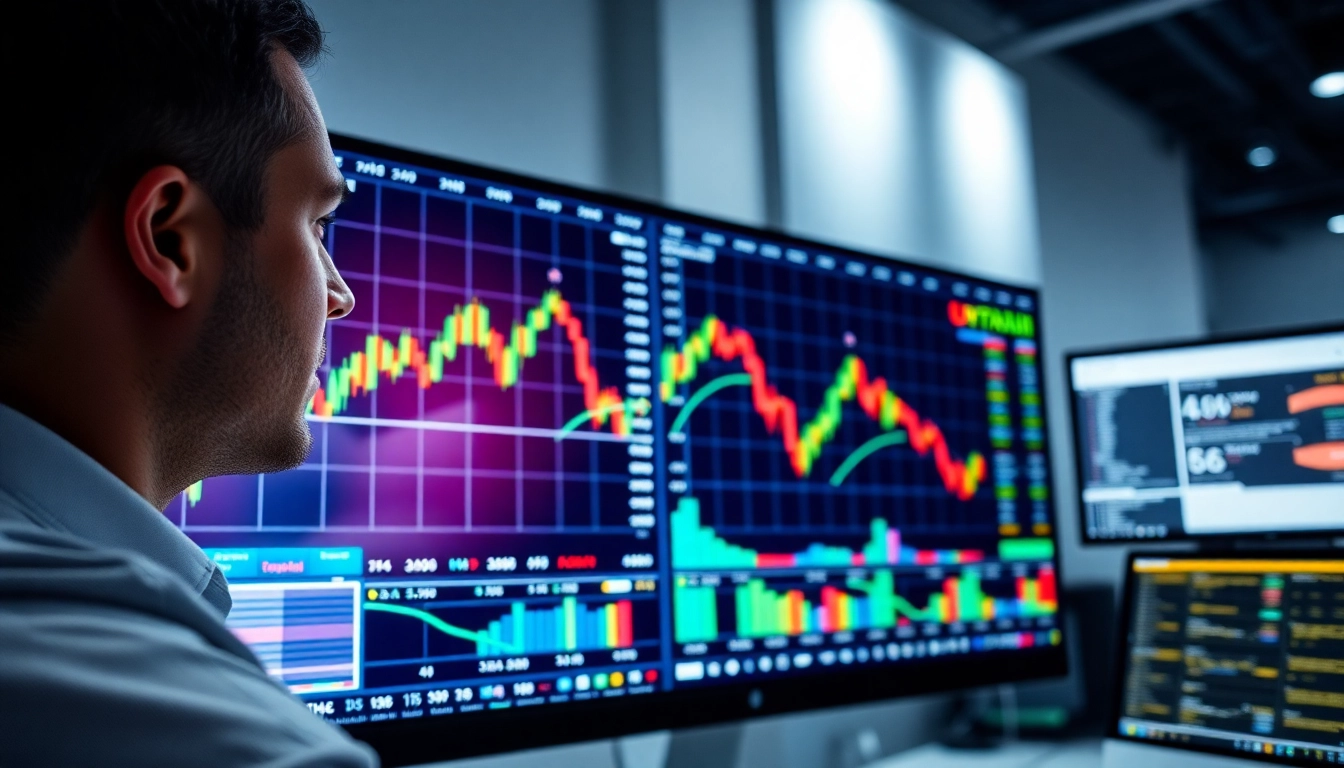Introduction to Trading View and Its Core Features
In the modern financial landscape, traders and investors require sophisticated yet user-friendly tools to analyze markets, develop strategies, and execute trades efficiently. trading view has established itself as a leading platform that combines powerful charting capabilities, social trading features, and real-time market data. This comprehensive overview will explore how Trading View’s interface, tools, and social integrations make it an indispensable resource for both novice and professional traders alike.
Understanding the Trading View interface and layout
Trading View’s interface is designed for clarity and flexibility, allowing users to navigate seamlessly across various functionalities. The layout primarily consists of a customizable chart area, side panels for watchlists and alerts, and a social feed for community ideas. The charting workspace provides real-time updates on stocks, cryptocurrencies, forex, commodities, and indices, which can be tailored with various timeframes, chart types, and overlays. The intuitive drag-and-drop functionality and keyboard shortcuts enable quick adjustments, making analysis efficient. The platform’s modular design allows traders to add multiple charts, compare assets, and organize their workspace according to individual preferences, fostering a focused trading environment.
Key tools and indicators available for traders
Trading View offers an extensive suite of analysis tools, including hundreds of technical indicators such as Moving Averages, Bollinger Bands, RSI, MACD, and Fibonacci retracements. Customizable drawing tools enable trend lines, support and resistance levels, channels, and patterns to be precisely marked on charts. Moreover, advanced features like oscillators, volume profiles, and pattern recognition assist traders in identifying potential entry and exit points. The platform’s scripting language, Pine Script, empowers users to develop and implement custom indicators and trading algorithms, paving the way for more sophisticated analysis and automated trading strategies.
Benefits of using Trading View for market analysis
Trading View combines accessibility with depth, making it suitable for traders at all levels. Its real-time data ensures timely decision-making, while cloud-based storage allows for easy access across devices. Market breadth is enhanced through social features, where traders share ideas, strategies, and insights, enriching collective knowledge. The platform’s ability to integrate fundamental analysis with technical data provides a holistic view of markets. Additionally, the accessibility of networked alerts and watchlist management helps traders stay alert to opportunities without constantly monitoring screens. Overall, Trading View’s comprehensive features streamline analysis, reduce information overload, and foster better-informed trading decisions.
How to Use Trading View for Effective Market Analysis
Chart customization and technical analysis techniques
Effective use of Trading View begins with mastering chart customization. Traders should define their preferred timeframes—ranging from minutes to monthly—and select appropriate chart types: candlestick, line, bar, or Heikin Ashi. Combining multiple indicators, such as trend-following and oscillators, provides layered insights. Recognizing chart patterns like head and shoulders, triangles, and double bottoms enhances predictive analysis. Additionally, drawing trendlines and support/resistance levels allows traders to visualize key areas of interest. Practicing these techniques with historical data and backtesting helps refine a trader’s analytical skills and confidence in decision-making.
Utilizing Trading View’s community ideas and social features
One of Trading View’s distinctive strengths is its vibrant social layer. Traders can publish ideas, share analysis, and comment on each other’s work. Engaging with this community offers diverse perspectives, new strategies, and confirmation of personal analysis. Leveraging community ideas also helps identify trending assets and emerging market sentiment. Active participation can incorporate real-time crowd insights into individual trading plans, fostering continuous learning and collaborative growth. For those seeking inspiration or validation, this social dimension acts as a valuable supplement to personal technical analysis.
Setting alerts and managing watchlists for timely decision-making
To stay ahead of market movements, traders should utilize Trading View’s robust alert system. Alerts can be set for price levels, indicator crossings, or specific pattern formations, with notifications sent via email, SMS, or app alerts. Proper watchlist management involves curating a set of assets aligned with trading strategies and updating them as market conditions evolve. Breaking down large watchlists into categories (e.g., swing trading, day trading) enhances focus. Using alerts and watchlists collectively ensures traders are promptly informed about market shifts, enabling swift action consistent with their strategy.
Integrating Trading View with Trading Strategies
Developing and backtesting trading strategies on Trading View
Trading View provides an environment to craft and evaluate trading strategies through its Pine Script language. Traders can design systematic approaches, test them against historical data, and adjust parameters for optimal performance. Backtesting involves simulating trades based on predefined rules, assessing profitability, drawdowns, and win ratios. Visual analysis through chart overlays and trade logs helps identify strengths and weaknesses within strategies, guiding iterative improvements. Incorporating risk-reward considerations and filtering criteria ensures strategies are robust before deployment.
Using Trading View’s scripting for automated trading signals
Pine Script enables automation of trading signals, alerts, and even order execution when connected to compatible trading accounts. Traders skilled in scripting can develop custom indicators that generate buy/sell signals, automate pattern recognition, and optimize entry and exit points. Automation reduces emotional biases and enhances discipline. Proper testing and validation are critical to avoid false signals, and traders should implement safeguards like stop-loss and take-profit levels to manage risks effectively in automated trading setups.
Aligning Trading View analysis with risk management practices
While technical analysis offers valuable insights, integrating solid risk management is paramount. Traders should define position sizes based on account size and volatility, set stop-loss orders at logical levels, and diversify their trades to avoid overexposure. Using Trading View’s alerts and analysis tools helps identify optimal points to exit trades, minimizing losses and protecting gains. Regularly reviewing trading performance via platform analytics and community feedback fosters disciplined, systematic risk management aligned with individual trading objectives.
Maximizing Trading View’s Mobile and Desktop Platforms
Optimizing charts and alerts on mobile devices
Trading View’s mobile application offers a near-identical experience to its desktop counterpart, enabling traders to analyze charts, set alerts, and participate in the social network on the go. To optimize mobile use, users should customize their app layout for quick access to key features, enable push notifications for critical alerts, and utilize mobile-specific tools like drawing and annotation. Ensuring the app is updated guarantees compatibility with the latest features and security enhancements, allowing traders to respond swiftly to market developments anytime, anywhere.
Features specific to Trading View desktop applications
The desktop platform provides advanced analytical capabilities, multitasking with multiple charts, and integration with brokerage accounts for direct trading execution. Features like large screen real estate, multiple workspace configurations, and faster data processing support intensive analysis. Collaboration tools, such as live sharing of charts and ideas with other traders, are more accessible on the desktop. Utilizing these features enhances strategic planning and allows for a more detailed examination of complex trading setups.
Syncing data across devices for seamless trading experience
Trading View’s cloud-based architecture ensures synchronization across all devices. Traders can start analyzing a chart on their desktop while commuting with their mobile device, with all settings, watchlists, and alerts intact. Proper account setup and regular sync checks prevent data loss and maintain consistency. This seamless integration ensures that traders remain connected to the markets and can act swiftly irrespective of their location, greatly enhancing overall trading efficiency.
Performance Metrics and Industry Insights on Trading View
Tracking market trends and sentiment analysis
Market sentiment is a crucial factor influencing asset prices. Trading View offers sentiment indicators, social gauges, and integrated news feeds that help assess overall market mood. Sentiment analysis tools, coupled with volume data and social activity, reveal crowd behaviors that precede major price movements. By monitoring trending ideas and hot assets within Trading View’s community, traders can gauge sentiment shifts and adapt their strategies proactively, increasing the likelihood of trading success.
Evaluating trading strategies using Trading View analytics
Backtesting results, performance reports, and risk-reward ratios presented within Trading View serve as quantitative evaluations of trading strategies. Continuous monitoring and tweaking based on live data and historical performance help traders refine their approaches. Visual analytics enable quick identification of underperforming strategies or market conditions where certain setups excel, fostering data-driven decision-making and strategic adjustments over time.
Case studies: Successful traders leveraging Trading View features
Many top traders have publicly shared how Trading View’s comprehensive analysis tools, social insights, and automation capabilities have contributed to their success. For example, some have backtested and refined algorithmic strategies using Pine Script, while others benefit from community ideas to identify trending opportunities early. These real-world applications demonstrate the platform’s versatility, emphasizing that mastery of Trading View’s features can significantly improve trading outcomes.



